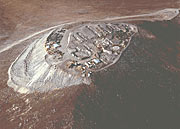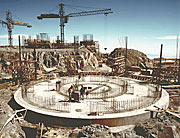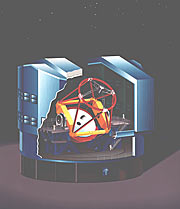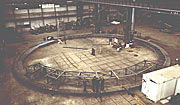Comunicato Stampa
Full Speed Ahead for ESO's Very Large Telescope
First enclosure on its way to Paranal!
29 Settembre 1994
During the past months, vast progress has been made in the construction of ESO's 16-metre equivalent Very Large Telescope (VLT). This major scientific and technological project aims at installing the world's largest optical telescope in the form of four interconnected telescopes with 8.2-metre mirrors on the Paranal mountain in the Chilean Atacama desert. It continues to be on schedule as it heads towards its completion, just after the year 2000.
An important milestone will be reached in early October 1994 when the first large shipment containing heavy steel parts of the enclosure for VLT Unit Telescope no. 1 leaves the Italian port of Genova [1]. Meanwhile the construction work on the Paranal site is also progressing very well. It is now expected that, as planned, the first enclosure will be ready in May 1995 to receive the first 8.2-metre telescope.
This Press Release is accompanied by four colour pictures that illustrate some of the most recent developments.
CONSTRUCTION PROGRESS IN EUROPE
Considerable progress has been made by ESO's industrial partners in Europe, and the VLT Project has now entered into a new and dynamic phase of construction.
The first 8.2-metre mirror is currently in the middle of a two-year polishing process at the REOSC company near Paris, and the first interferometric tests have shown that this very delicate operation is progressing well. The enormous mirror surface, with a total area of more than 50 m^2, is slowly but steadily approaching the desired shape which must be achieved within a few hundred-thousandths of one millimetre over the entire surface.
Mirror blank no. 2 is now ready at the Schott factory in Mainz (Germany) and will be delivered by barge transport to REOSC in October 1994. Blank no. 3 has successfully completed the critical ceramization phase and blank no. 4 will soon receive the same treatment.
The circular steel track, 18 metres in diameter, that will support Telescope no. 1 has now been
successfully machined at the Ansaldo factory in Genova (Italy). The substructure on which this track and the complete telescope steel structure will be pre-erected before shipment to Chile was constructed at the Ansaldo factory in Milan. Elements of the telescope fork structure were also welded and machined here. In addition, many of the subsystems of the telescope tube, motors and encoders are now in an advanced phase of manufacture.
The full integration of the first telescope will take place in Milan during the test-assembly phase in the first half of 1995. It will then for the first time be possible to fully appreciate the enormous size of this structure. All structural elements for the complex enclosure that will protect Telescope no. 1 have now been machined at IDROMACCHINE in Mestre near Venice. It was decided to perform a pre-erection assembly there of a few critical parts in order to test thoroughly performances and interfaces.
THE FIRST SHIPMENT
At the beginning of October 1994, the first shipment of steel parts of this enclosure with a total weight of more than 100 tons will leave Europe for the sea journey to Chile. While the smaller parts are packed in large containers, special packing is necessary for the very large structures. The ship will depart from the port of Genova and is expected to dock in Antofagasta towards the end of November 1994, after which the parts will be transported by truck to the top of Paranal.
This first shipment will be soon be followed by others; it is expected that consignments of about 100 tons each will be sent to Chile every two weeks over the next eight months.
WORK AT PARANAL PROGRESSES RAPIDLY
Meanwhile, the construction work on the top of Paranal continues at full speed. About 350 people employed by the construction firm SKANSKA/Belfi now live in the completed base camp and work in shifts day and night on the mountain.
The photos accompanying this Press Release show the state of the extensive work by mid-September. The tunneling for the many underground passages is finished, the concrete base for Telescope no. 1 is nearing completion, and the baseplate for no. 2 is ready. The aerial view gives a vivid impression of well-organised "chaos" now reigning at Paranal and it is hard to believe that when this phase is over, supposedly towards the end of 1996, only the four telescope enclosures will be seen on the completely flat mountain platform -- all other infrastructures, including the large interferometric laboratories, will again have been completely covered. This is necessary to ensure the best possible wind-flow pattern over and around the mountain and enclosures and thereby also allow the sharpest possible astronomical images to be obtained with the giant telescopes.
The anti-seismic supports to be embedded in the foundations for protection against the strongest earthquakes, have already arrived in Chile and will be installed below enclosure no. 1 during the next few weeks. It is then intended to start the erection of the major parts of this enclosure in mid-December 1994, immediately following the termination of the construction of the concrete support.
This work will start with the assembly of the lower, fixed part of the structure that carries the circular track on which the upper part rotates. It is expected that this will last about six months and that the first enclosure will be ready in May 1995. The erection of enclosure no. 2 will begin immediately afterwards and will be followed by nos. 3 and 4. This work should be terminated by the end of 1996.
THE NEXT STEPS
The heavy parts for Telescope no. 1 will arrive at Paranal shortly after May 1995. However, before the telescope assembly inside the enclosure can begin, a rotating coude platform will have to be installed below, directly on the base plate that will also carry the entire telescope structure above.
The lower telescope structure will then be built on top of the two circular tracks and later the telescope tube will be attached at the top. Then follows the installation of the optics, including the 8.2-metre main mirror and the first astronomical instruments.
Then arrives the long-awaited moment when the telescope will open its giant eye towards the Universe for the first time; astronomers refer to this special event as "first light". Finally, the telescope will be thoroughly tested, before it is made generally available to the astronomers. This will probably happen about three years from now, in late 1997. The other three telescopes will be installed during the following years.
Sul Comunicato Stampa
| Comunicato Stampa N": | eso9414 |
| Legacy ID: | PR 14/94 |
| Nome: | Paranal, Very Large Telescope |
| Tipo: | Unspecified : Technology : Observatory Unspecified : Technology : Observatory : Telescope |
| Facility: | Very Large Telescope |
Our use of Cookies
We use cookies that are essential for accessing our websites and using our services. We also use cookies to analyse, measure and improve our websites’ performance, to enable content sharing via social media and to display media content hosted on third-party platforms.
ESO Cookies Policy
The European Organisation for Astronomical Research in the Southern Hemisphere (ESO) is the pre-eminent intergovernmental science and technology organisation in astronomy. It carries out an ambitious programme focused on the design, construction and operation of powerful ground-based observing facilities for astronomy.
This Cookies Policy is intended to provide clarity by outlining the cookies used on the ESO public websites, their functions, the options you have for controlling them, and the ways you can contact us for additional details.
What are cookies?
Cookies are small pieces of data stored on your device by websites you visit. They serve various purposes, such as remembering login credentials and preferences and enhance your browsing experience.
Categories of cookies we use
Essential cookies (always active): These cookies are strictly necessary for the proper functioning of our website. Without these cookies, the website cannot operate correctly, and certain services, such as logging in or accessing secure areas, may not be available; because they are essential for the website’s operation, they cannot be disabled.
Functional Cookies: These cookies enhance your browsing experience by enabling additional features and personalization, such as remembering your preferences and settings. While not strictly necessary for the website to function, they improve usability and convenience; these cookies are only placed if you provide your consent.
Analytics cookies: These cookies collect information about how visitors interact with our website, such as which pages are visited most often and how users navigate the site. This data helps us improve website performance, optimize content, and enhance the user experience; these cookies are only placed if you provide your consent. We use the following analytics cookies.
Matomo Cookies:
This website uses Matomo (formerly Piwik), an open source software which enables the statistical analysis of website visits. Matomo uses cookies (text files) which are saved on your computer and which allow us to analyze how you use our website. The website user information generated by the cookies will only be saved on the servers of our IT Department. We use this information to analyze www.eso.org visits and to prepare reports on website activities. These data will not be disclosed to third parties.
On behalf of ESO, Matomo will use this information for the purpose of evaluating your use of the website, compiling reports on website activity and providing other services relating to website activity and internet usage.
Matomo cookies settings:
Additional Third-party cookies on ESO websites: some of our pages display content from external providers, e.g. YouTube.
Such third-party services are outside of ESO control and may, at any time, change their terms of service, use of cookies, etc.
YouTube: Some videos on the ESO website are embedded from ESO’s official YouTube channel. We have enabled YouTube’s privacy-enhanced mode, meaning that no cookies are set unless the user actively clicks on the video to play it. Additionally, in this mode, YouTube does not store any personally identifiable cookie data for embedded video playbacks. For more details, please refer to YouTube’s embedding videos information page.
Cookies can also be classified based on the following elements.
Regarding the domain, there are:
- First-party cookies, set by the website you are currently visiting. They are stored by the same domain that you are browsing and are used to enhance your experience on that site;
- Third-party cookies, set by a domain other than the one you are currently visiting.
As for their duration, cookies can be:
- Browser-session cookies, which are deleted when the user closes the browser;
- Stored cookies, which stay on the user's device for a predetermined period of time.
How to manage cookies
Cookie settings: You can modify your cookie choices for the ESO webpages at any time by clicking on the link Cookie settings at the bottom of any page.
In your browser: If you wish to delete cookies or instruct your browser to delete or block cookies by default, please visit the help pages of your browser:
Please be aware that if you delete or decline cookies, certain functionalities of our website may be not be available and your browsing experience may be affected.
You can set most browsers to prevent any cookies being placed on your device, but you may then have to manually adjust some preferences every time you visit a site/page. And some services and functionalities may not work properly at all (e.g. profile logging-in, shop check out).
Updates to the ESO Cookies Policy
The ESO Cookies Policy may be subject to future updates, which will be made available on this page.
Additional information
For any queries related to cookies, please contact: pdprATesoDOTorg.
As ESO public webpages are managed by our Department of Communication, your questions will be dealt with the support of the said Department.




